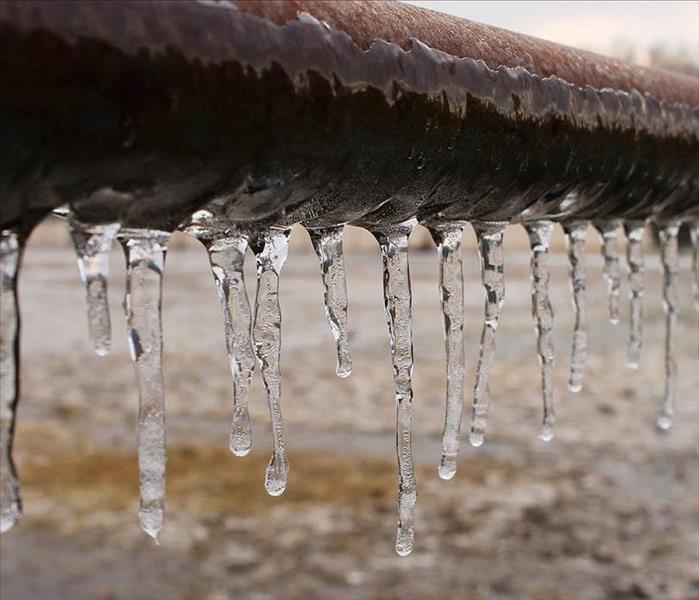Cold Winter Weather Help: Why Pipes Burst and Why it's Important
2/27/2019 (Permalink)
When water freezes, it expands. That’s why a can of soda explodes if it’s put into a freezer to chill quickly and forgotten. When water freezes in a pipe, it expands the same way. If it expands enough, the pipe bursts, water escapes and serious damage results.
WHY PIPES BURST?
Surprisingly, ice forming in a pipe does not typically cause a break where the ice blockage occurs. It’s not the radial expansion of ice against the wall of the pipe that causes the break. Rather, following a complete ice blockage in a pipe, continued freezing and expansion inside the pipe causes water pressure to increase downstream between the ice blockage and a closed faucet at the end. It’s this increase in water pressure that leads to pipe failure. Usually the pipe bursts where little or no ice has formed. Upstream from the ice blockage the water can always retreat back towards its source, so there is no pressure build-up to cause a break.
Water has to freeze for ice blockages to occur. Pipes that are adequately protected along their entire length by placement within the building’s insulation, insulation on the pipe itself, or heating, are safe.
MITIGATING THE PROBLEM
Water freezes when heat in the water is transferred to subfreezing air. The best way to keep water in pipes from freezing is to slow or stop this transfer of heat. Ideally, it is best not to expose water pipes to subfreezing temperatures, by placing them only in heated spaces and keeping them out of attics, crawl spaces and vulnerable outside walls. In new construction, proper placement can be designed into the building. In existing houses, a plumber may be able to re route at-risk pipes to protected areas, although this may not be a practical solution. If the latter is the case, vulnerable pipes that are accessible should be fitted with insulation sleeves or wrapping (which slows the heat transfer), the more insulation the better. It is important not to leave gaps that expose the pipe to cold air. Hardware stores and home centers carry the necessary materials, usually in foam rubber or fiberglass sleeves. Better yet, plumbing supply stores and insulation dealers carry pipe sleeves that feature extra thick insulation, as much as 1 or 2 inches thick. The added protection is worth the extra cost.
LETTING THE WATER RUN
Letting a faucet drip during extreme cold weather can prevent a pipe from bursting. It’s not that a small flow of water prevents freezing; this helps, but water can freeze even with a slow flow. Rather, opening a faucet will provide relief from the excessive pressure that builds between the faucet and the ice blockage when freezing occurs. If there is no excessive water pressure, there is no burst pipe, even if the water inside the pipe freezes. A dripping faucet wastes some water, so only pipes vulnerable to freezing (ones that run through an unheated or unprotected space) should be left with the water flowing. The drip can be very slight. Even the slowest drip at normal pressure will provide pressure relief when needed. Where both hot and cold lines serve a spigot, make sure each one contributes to the drip, since both are subjected to freezing. If the dripping stops, leave the faucet(s) open, since a pipe may have frozen and will still need pressure relief.
The Insurance Institute for Business and Home Safety have a full article HERE
If you notice a pipe burst, call a plumber immediately to have your water turned off. Any resulting leaks or water damage can be be handled by your friendly neighbourhood SERVPRO.




 24/7 Emergency Service
24/7 Emergency Service
